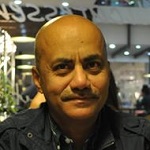Like the fragrance of a rose, the brief history of Art Now Pakistan does not lie outside, but is embedded within: In the text and imagesproduced, shar
Like the fragrance of a rose, the brief history of Art Now Pakistan does not lie outside, but is embedded within: In the text and imagesproduced, sharedand communicated every month. This material contains a range of approaches, often diverse,conflicting and contradictory towards the art of our times and world. Constructed with multiple views, visions and voices, the history of art is being written through this format, in which, instead of a singular author (authority), a composite of ideas, opinions and issues are formulated.
However there are variousways to read and record History, usually subject to change with each new phase in the course of man’s life on this earth. There has been a notion of sacredness attached to history – like the concept of holiness is connected with the written word (interesting the meaning of The Bible is the book) mainly because documenting history has been equated with preserving truths, facts and accurate versions of events.
The discipline of art history was not different either, as old texts on artists were considered the authentic and sole source to know the reality behind pictorial pursuits. But over the years validity and worth of art history became a point of question and contention. Since artists, especially in the age of Modernity, often surprised and surpassed historians of their times; and in many cases, history of a period, movement or an individual artist has to be revised and rewritten.
The truth about this process of preserving truth (the history of art) needs to be investigated and explored. In the present issue of Art Now Pakistan, the theme of art history is mapped through different angels. How this subject, from pure academic exercise to informal body of writing has been instrumental and important in protecting, conserving and continuing the cultural expression of a nation, thus not being a form of knowledge about the distant past, but a combination of thoughts and facts, which has to be relevant for various periods.
In her essay Gemma Sharpe addresses similar concerns, which are also explored in another method by UsmanSaeed in his photo-essay. Saeed’s series of images convey a sense of specific experience in time, which may survive outside the domain of art, but does not exist beyond the realm of aesthetics. The present issue also offers the profile of Jalal Uddin Ahmed, the writer of first book on Pakistani art. His contribution and supportto the art of this nation is insurmountable and unmatchable. Like him, Marjorie Husain has written extensively – through her articles and books – on the art and artists of this country. In her interview with HajraHaider, she talks about her views on the history of Pakistani art.
Along with exhibition reviews, book review and news of art events, the recent issue is a means to ponder upon the practice of prolonging past. As with each moment, the present slips from our grips in order to turn into past; so a reflection on history is a way of recollecting ourselves bit by bit, because the future has no future if it is not the future of the past!

Editor
QuddusMirza

COMMENTS